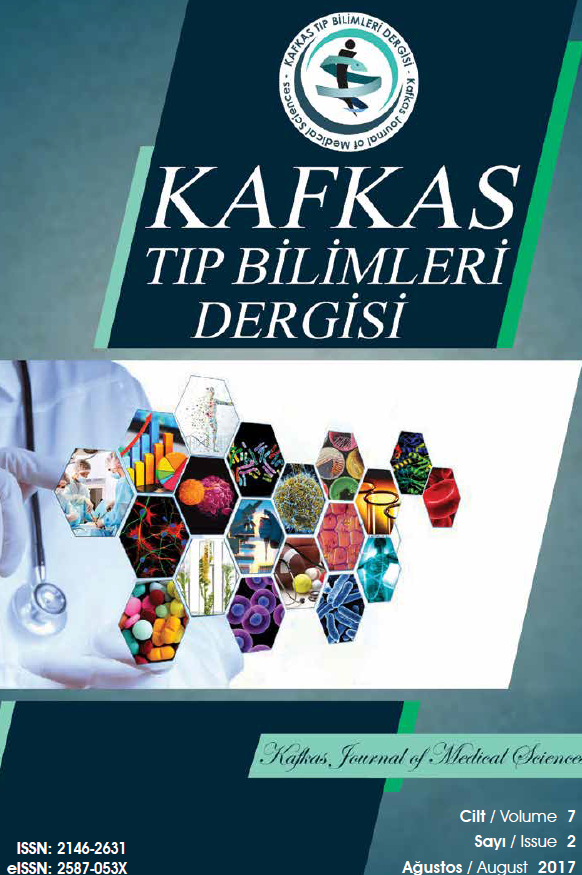Yoğun bakımlardaki hastane enfeksiyonları: Etiyoloji ve predispozan faktörler
Bu çalışmada genel yoğun bakımda gelişen hastane enfeksiyonu oranı, sebepleri ve predispozisyon yaratan etkenleri tespit etmeyi ladık.Yöntem: Genel yoğun bakım ünitesinde hospitalizasyon sonrası hastane enfeksiyonu gelişen 146 hasta bu çalışmada yer aldı. Hastalar 1 Ocak ve 31 Aralık 2010 tarihleri arasında Adıyaman Devlet Hastanesi ve Adıyaman 82. Yıl Devlet Hastanesi’de yatan 2135 hasta arasından retrospektif olarak seçildiler.Mortalite sebeplerini analiz etmek için yaş, cinsiyet, hastanede kalma süresi, eşlik eden hastalık, santral venöz, periferik venöz ve üriner kateterizasyon ile endotrakeal tüp uygulaması oranları periyod sonunda ölen ve iyileşen hastalarda karşılaştırıldılar.Veriler SPSS 16,0 paket program kullanılarak analiz edildi. Ortalama ± standart sapma ve yüzde tanımlayıcı istatistik sonuçlarını sunmak için kullanıldılar. Bağımsız değişkenler t testi ki-kare testi veri analizinde kullanıldılar.BULGULAR: Hastane enfeksiyonlarında yașın ilerlemesi ve erkek olmak mortalite açısından risk faktörleriydi. Hastanede kalıș süresi ise mortalite oranını etkilemedi (p>0,05). Santral venöz kateteri olan ya da entübe edilen hastalarda mortalite oranı daha yüksekti (p=0,001 ver 0,016). Diyabet (p=0,003) ve böbrek yetmezliği (p=0,001) eșlik eden hastalık olarak mortalite oranını arttırdılar. Yoğun bakımda bir cerrahi ișlem sonrası yatılması, diğer sebeplere göre daha az mortaliteye sebep oldu. Infeksiyon oranları incelendiğinde, gram negatif bakteri, gram pozitif bakteri ve Candida türleri sırasıyla %51, 35,2 ve 13,8 oranında saptandılar. Elde edilen kültürlerde en sık üreyen bakteri metisiline dirençli stafilokok, E. coli ve A. baumaniiydi. Üreyen organizmalarla mortalite ilișkisinin incelenmesi, ilginç olarak, kültürlerde Candida türleri ve metisiline dirençli stafilokok üremesiyle mortalitenin arttığını gösterdi. SONUÇ: Yoğun bakımda takipleri gereken hastalarda ileri yaș, erkek cinsiyeti, santral venöz kateter ve endotrakeal tüp uygulanması ile hastanın eșlik eden hastalıkları mortaliteyi artıran sebeplerdirler.
Nosocomial infections in intensive care units: Etiology and predisposing factors
The aim of this study was to evaluate the rate, causes, and predisposing factors of hospital infections in the general intensive care unit. Methods: The study included 146 patients diagnosed with nosocomial infections following the hospitalization in the general intensive care unit. Patients were selected retrospectively among the 2135 patients admitted in Adiyaman State Hospital and Adiyaman 82nd Year State Hospital between January 1st and December 31st of 2010.To analyze the causes of the mortality; age, gender, hospital staying time, accompanying disease, interventions like central, venous, nasogastric or urinary catheterization and endotracheal intubation rates were compared in patients died at the end of the period with the ones who survived. The data were analysed by using SPSS 16.0 package program. Mean ± standard deviation and percentage distributions were used as descriptive statistics. Independent samples T-test and chi square test were used for data analysesRESULTS: Nosocomial infections were seen more frequently in elder patients and the male gender was a risk factor for mortality. Hospital stay time did not effect the mortality rate (p>0.05). Patients with a central venous catheter or an endo tracheal tube had higher mortality rates (p= 0.001 and 0.016, respectively). Diabetes and renal failure as accompanying diseases increased (p= 0.003 and 0.001, respectively) the mortality rates. Hospitalization in the intensive care unit following a surgical procedure was a less frequent cause for mortality in comparison with other hospitalization causes. When the percentages of the infections were analyzed, gram negative bacteria, gram positive bacteria and Candida spp were found in 51, 35.2 and % 13.8% of the cases, respectively. Most common bacteria grown in obtained cultures were methicillin resistant staphylococci, Escherichia coli, and A. baumannii. Evaluation of the relation between the grown organisms and the mortality, interestingly, showed that mortality was increased when Candida spp or methicillin resistant staphylococci were grown in culture. CONCLUSION: Advanced age, male gender, central venous catheterization, endotracheal intubation and the accompanying diseases increase the mortality rates in patients hospitalized in the intensive care units.
